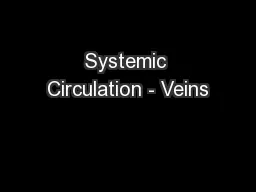

Portal Circulation The hepatic portal system is designed to take nutrient rich venous blood from the digestive tract capillaries and transport it to the sinusoidal capillaries of the liver As it percolates through the liver sinusoids the hepatocytes of the liver acting as the chemical fa ID: 216959
Download Presentation The PPT/PDF document "Systemic Circulation - Veins" is the property of its rightful owner. Permission is granted to download and print the materials on this web site for personal, non-commercial use only, and to display it on your personal computer provided you do not modify the materials and that you retain all copyright notices contained in the materials. By downloading content from our website, you accept the terms of this agreement.
Slide1
Systemic Circulation - VeinsSlide2
Portal Circulation
The
hepatic portal system
is designed to take nutrient- rich venous blood from the digestive tract capillaries, and transport it to the sinusoidal capillaries of the liver.
As it percolates through the liver sinusoids, the hepatocytes of the liver, acting as the chemical factories of the body, extract and add what they wish to maintain homeostasis (extracting sugars, fats, proteins when appropriate and then dumping them back into the circulation when necessary).Slide3
Portal CirculationSlide4
Fetal Circulation
The fetus has special circulatory requirements because their lungs, kidneys and GI tract are non-functional.
The fetus derives its oxygen and
nutrients and eliminates wastes
through the maternal blood supply
by way of the placenta. Normally,
there is no maternal/fetal mixing;
the fetus is totally dependant on
capillary exchange.Slide5
Oxygenated blood leaves the placenta through the umbilical vein. It then bypasses the liver via the ductus venosus and dumps into the inferior vena cava en route to the right heart.
This oxygen-rich blood then
bypasses the lungs by
traveling to the left heart
through the foramen ovale.
Fetal CirculationSlide6
Blood remaining in the right heart that manages to flow through the right ventricle meets with very high resistance from the closed and soggy lungs.
This blood is diverted into the
left-sided circulation by passing
through the ductus
arteriosus before returning
to the placenta via the
umbilical arteries.
Fetal CirculationSlide7
Fetal circulation (before birth)Slide8
Neonatal Circulation After Birth
At birth, the neonate’s lungs open and in just a few seconds, there is a massive drop in pulmonary vascular resistance.
Blood now entering the right heart now sees lower pressure looking into the lungs and has no “incentive” to flow through the foremen ovale or the ductus arteriosus.
Another change also occurs very rapidly - the umbilical cord is severed.
And so begins the adult pattern of blood flow.Slide9
Neonatal Circulation After Birth
Within hours, days, or weeks after birth, the umbilical vein atrophies to become the ligamentum teres.
The ductus venosus atrophies to become the ligamentum venosum.
The foramen ovale becomes the closed fossa ovale.
The ductus arteriosus atrophies to become the ligamentum arteriosum.
Umbilical arteries atrophy to become the medial umbilical ligaments.Slide10
Neonatal Circulation After BirthSlide11
End of Chapter 21
Copyright 2012 John Wiley & Sons, Inc. All rights reserved. Reproduction or translation of this work beyond that permitted in section 117 of the 1976 United States Copyright Act without express permission of the copyright owner is unlawful. Request for further information should be addressed to the Permission Department, John Wiley & Sons, Inc. The purchaser may make back-up copies for his/her own use only and not for distribution or resale. The Publisher assumes no responsibility for errors, omissions, or damages caused by the use of these programs or from the use of the information herein.